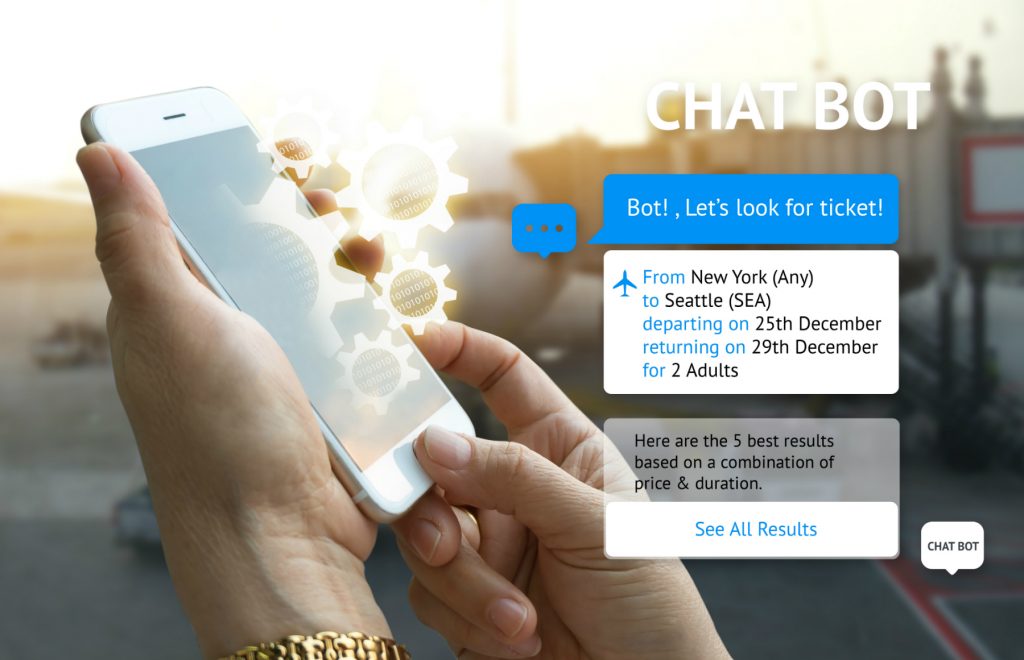Not so long ago, the customer journey followed a fairly regular and rhythmic pattern. A potential traveler may have gathered information from a number of companies, then browsed through brochures, called a few tour operators to clear up unanswered questions, and done some comparison shopping before booking a trip. Today’s travelers go through a similar customer journey, but they aren’t necessarily going to wait around for someone to answer their questions over the phone during working hours or for a paper brochure to arrive in the mail so they can read up on a destination or trip.

Technology integration into everyone’s lives means it’s increasingly important for companies to be ready to respond whenever and wherever potential customers want. Realizing this, companies are integrating chat features into their websites that are available 24 hours a day.
The Growth of Chat
Online, around-the-clock availability is made possible by chatbots, which are automated conversation systems powered by artificial intelligence that can understand and answer common customer questions. For example, KLM’s “smart assistant,” BB, can assist customers with booking a ticket, finding travel inspiration, or packing a bag.
According to Gartner, 85% of customer interactions will be managed without a human by 2020. In the travel, transportation, and hospitality industries, chatbot usage will increase by 241% by mid-2020, according to recent research by Salesforce. “We’re seeing more and more companies deploy chatbots, both in the travel industry and beyond,” said Tim de Paris, chief technology officer at Decibel, a company that helps travel brands understand and improve the online booking experience. “Chatbots are meant to serve as an assistant so that people going to a website can get what they came for.”
Chatbot or Live Person?
Chatbots’ constant availability to answer simple, straightforward, and common questions as well as their ability to free up human agents and reduce overhead costs make them an appealing prospect for adventure travel companies. However, they need to be designed appropriately to meet and exceed customer expectations; poorly implemented chat services can turn potential customers toward other companies that can meet their needs. “The problem with most chatbot technology is that they pop up asking if you need help at almost always the wrong time,” de Paris said. “This interrupts the flow of the customer’s experience on the website, and, honestly, can hurt brand loyalty as it can be seen as an annoyance rather than something helpful.”
The truth is not every situation is appropriate for a chatbot. More than half (57%) of respondents to the Salesforce survey said human customer service agents are more effective at handling their needs than a chatbot. Additionally, 49% said humans are more efficient. Sometimes it’s better to have a live person on the receiving end of a chat feature, especially in the travel and tourism industry, where potential customers are making sizable purchases with multi-faceted issues related to safety, cultural differences, and lifetime dreams and goals. When that’s the case, a live chat feature may be a better option.
“Live chat gives customers instant access to human agents in real time, whereas chatbots provide automated conversations via artificial intelligence and natural language processing. They each serve a purpose in a good customer experience strategy; bots can handle simple, routine requests and free agents up for the more complicated or sensitive customer requests,” said Jeff Epstein, vice president of product at Comm100, a company that provides omnichannel customer experience solutions.
The Salesforce survey found that, if people can save time, 46% would opt to use a chatbot. “In the travel industry, chatbots are great for handling routine requests like confirming reservation details, providing booking information, and sharing general information,” Epstein said. A human agent is more suitable to address more complex or urgent needs. “A customer contact center reaches its peak efficiency when bots and human agents are working together,” he said.
Considerations for Implementing a Chat Service
With so much choice at their fingertips, today’s customer service experience needs to be nimble and focused specifically on what customers want and need. Companies that can hone in on customization and personalization stand to benefit by responding when and with what customers need right when they need it. “Companies adopting chatbot technology should ensure it is deployed when a customer is actually frustrated and can’t find what they need,” de Paris said. “Only when brands have the capacity to understand how customers and prospects interact on their digital properties and how they feel about those experiences can they deploy chatbots at the most opportune time.”
Technology isn’t sophisticated enough yet to completely replace live chats with chatbots, and for the travel and tourism industry, which sells experiences versus products, it may never be appropriate to fully replace actual human responses with artificial intelligence. However, implementing a chatbot and backing it up with live chat assistance can help companies streamline customer service needs while remaining available and relevant to digitally connected customers. “Any company using chatbots should always inform a customer when they are interacting with a bot versus a human agent,” Epstein said. “Today’s customers are happy to connect with a chatbot if it means they get the answers they need efficiently, but it should be made perfectly clear to them when the interaction begins.”
As important and helpful as chat technology may become for the travel industry, companies need to be mindful that implementing chat technology isn’t a one-and-done administrative task to be ticked off of a to-do list. “Live chat and chatbots are never a ‘set it and forget it’ solution, so businesses must always be adjusting and taking advantage of new functionalities that may be available,” Epstein said.
